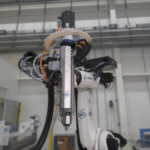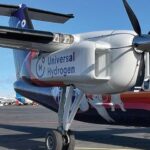The University of Texas at Arlington and the UTA Research Institute will develop state-of-the-art computational methodologies to predict the strength and life of rotor blade assemblies, known as rotor spars, through a new $1 million grant by NASA that enables the institute to research and discover ways to build safer helicopters and commercial airplanes
Endel Iarve, an accomplished research scientist and expert in composite materials, will lead the three-year project called “Development of Fatigue Life Prediction of Rotor Spars by Using Discrete Damage Modeling”.
Iarve joined UTA in 2015 as a strategic addition to the newly created Institute for Predictive Performance Methodologies, part of two-pronged strategy to increase research activity and to engage corporations in the process of translating discoveries into practical uses. The Institute is led by Kenneth Reifsnider, an internationally recognized expert in high temperature energy systems and composite materials and a member of the prestigious National Academy of Engineering.
“People want to know — especially the helicopter manufacturers — they want to be able to predict how long these parts are going to last,” institute executive director Mikey McCabe said. “Also, even more importantly is to detect when they might fail before it actually happens.”
The NASA project is funded through the federal agency’s Aeronautics Research Mission Directorate in alignment with the Advanced Composites Project, which focuses on providing safe and sustainable U.S. and global aviation. Researchers also are working to reduce the timeline for development and certification of state-of-the-art composite materials and structures, which will help make advanced composite components more competitive in commercial aircraft.
Composites are engineering materials that can be created to form fiberglass composites and carbon fiber composites, which will be the subject of the research, Iarve said.
“These structures are nominally much more efficient than steel because they are way lighter and, in some cases, can be just as strong as any engineered materials,” Iarve said. “They are complex materials, and that’s why they fail in a very complicated way when they break.”
“When a new aircraft is made, millions of tests have to be performed to qualify the material, which is expensive, Iarve said. The only alternative is to test the materials through a computer model”, he said.
State Sen. Kelly Hancock, R-North Richland Hills, said the NASA project is evidence of the University’s increasing contribution to the aerospace industry.
“UTA is becoming a worldwide leader and a research partner with the aviation industry in establishing benchmarks that will have a permanent impact on computational aeronautic manufacturing,” Hancock said.
The goal of the UTARI effort is to extend advanced computational techniques to a larger and more complicated part of an aircraft, improving life prediction in rotorcraft structures.
UTARI Executive Director Mickey McCabe said Iarve’s research correlates with the University’s commitment to data-driven discovery under the Strategic Plan 2020: Bold Solutions|Global Impact.
“Iarve’s research uses data-driven discovery to create valuable models that will predict the life of larger aerospace components,” McCabe said. “It has strengthened an already strong Institute for Predictive Performance Methodologies and delivers a valuable tool needed by every aerospace manufacturer.”













